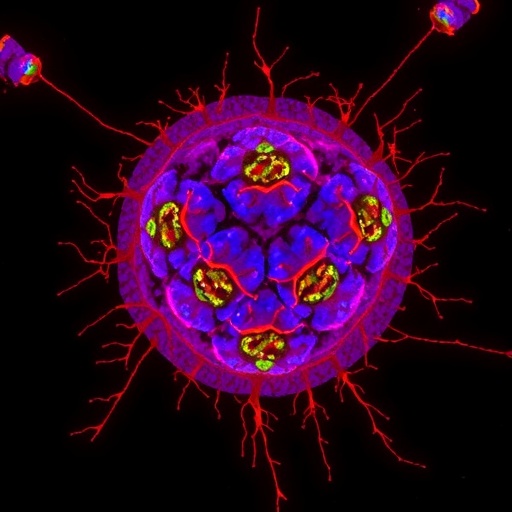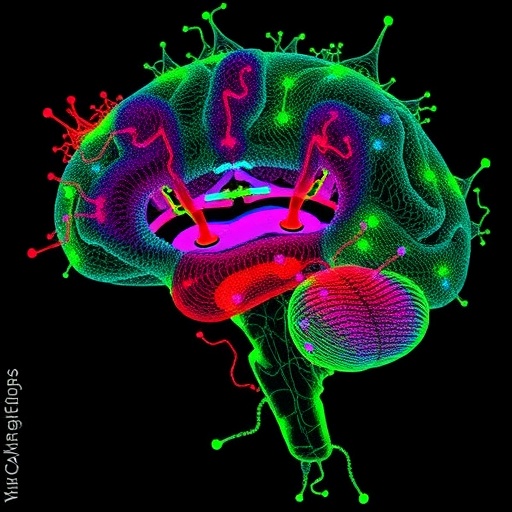In a groundbreaking study published in Cell Death Discovery, researchers have unveiled a novel molecular mechanism that opens promising avenues for glioma therapy. The investigation, led by You, Z., Wu, F., Zheng, Y., and colleagues, uncovers the pivotal role of microRNA-139-5p (miR-139-5p) in orchestrating ferroptosis, a regulated cell death pathway, by targeting the mevalonate pathway enzyme HMG-CoA reductase. This discovery sheds new light on the intricate interplay between lipid metabolism and cancer cell susceptibility to ferroptosis, offering hope for innovative therapeutic interventions against aggressive brain tumors.
Gliomas represent some of the most lethal and treatment-resistant primary brain cancers, often classified according to their histological and molecular features. Despite intensive research efforts, the prognosis for high-grade glioma patients remains dismal due to tumor heterogeneity and therapeutic resistance. Thus, there is an urgent need to dissect the molecular underpinnings that contribute to glioma progression and to identify vulnerabilities that can be exploited for targeted treatments.
The study focuses on miR-139-5p, a non-coding RNA molecule previously implicated in tumor suppression across various cancer types. The authors reveal that miR-139-5p functions as a critical regulator of ferroptosis by directly suppressing the expression of 3-hydroxy-3-methylglutaryl-CoA (HMG-CoA) reductase, an essential enzyme in the mevalonate pathway. The mevalonate pathway is well known for its role in cholesterol biosynthesis and cellular lipid homeostasis, factors intimately linked to membrane integrity and oxidative stress responses.
Through a series of meticulous molecular experiments, the team demonstrates that miR-139-5p binding to the 3’ untranslated region (UTR) of the HMG-CoA reductase mRNA decreases the enzyme’s translation and consequently reduces the biosynthesis of downstream metabolites. This suppression destabilizes cellular antioxidant defenses, making glioma cells more vulnerable to iron-dependent lipid peroxidation, the hallmark of ferroptosis. The findings situate miR-139-5p as a potent endogenous activator of ferroptotic cell death, a process whose induction is gaining traction as a promising anti-cancer strategy.
Beyond the molecular crosstalk, the research delves into the pathophysiological consequences within glioma models. Overexpression of miR-139-5p was found to significantly inhibit glioma cell proliferation and invasion in vitro, while also attenuating tumor growth in vivo. The ferroptotic nature of this inhibition was confirmed by the reversal of cell death upon lipophilic antioxidant treatment, underscoring the specificity of the cell death pathway engaged. Importantly, this approach appears to bypass resistance mechanisms commonly encountered with conventional apoptosis-inducing therapies.
The study also explores the metabolic ramifications of HMG-CoA reductase downregulation, a crucial step in statin pharmacology. By reducing mevalonate pathway flux, miR-139-5p mimics some effects of statins, which have been epidemiologically associated with lower glioma risk in certain patient populations. However, unlike systemic statin administration, miR-139-5p acts locally within tumor cells, potentially minimizing off-target effects and toxicity. This insight paves the way for developing microRNA-based therapeutics or combinational regimens that leverage ferroptosis induction alongside other modalities.
One of the key challenges in ferroptosis research is the intricate balance between pro-death lipid peroxidation and cellular antioxidant systems such as glutathione peroxidase 4 (GPX4). The current findings suggest that HMG-CoA reductase suppression by miR-139-5p interferes with the biosynthesis of isoprenoids—lipid molecules critical for the post-translational modification of proteins that maintain redox homeostasis. Disruption of this supply chain intensifies oxidative stress and potentiates ferroptotic cell death, a mechanistic insight that could inspire new biomarker development for patient stratification.
Moreover, the implications of miR-139-5p extend beyond glioma into broader cancer biology and neuro-oncology landscapes. Since dysregulated metabolic pathways and resistance to apoptosis are hallmarks shared among various tumors, targeting lipid metabolism and ferroptosis may become a cornerstone in precision oncology. This study’s demonstration of functional crosstalk between microRNAs and metabolic enzymes highlights a versatile regulatory axis amenable to therapeutic exploitation.
The authors underscore the translational potential of their discoveries by proposing therapeutic delivery systems for miR-139-5p, including nanoparticle carriers and viral vectors, tailored for selective tumor targeting. Such approaches could overcome the notorious blood-brain barrier and achieve effective miRNA modulation within glioma microenvironments. Early preclinical toxicology and pharmacokinetic profiling will be crucial in validating this strategy for future clinical trials.
Technologically, this work benefits from advanced molecular biology techniques, including luciferase reporter assays confirming direct miRNA-mRNA interaction, lipid peroxidation assays quantifying ferroptosis, and in vivo imaging of orthotopic glioma models to assess tumor progression. Integration of transcriptomic and metabolomic analyses further corroborates the mechanistic insights, illustrating shifts in metabolic flux and gene expression patterns upon miR-139-5p modulation.
This research contributes to a growing body of evidence that microRNAs are master regulators of cell fate decisions, capable of reprogramming tumor metabolic pathways to favor cell death over survival. The identification of HMG-CoA reductase as a novel target for ferroptosis-inducing microRNAs enriches our understanding of tumor metabolism and invites the design of next-generation molecular therapies.
While the promise is substantial, challenges remain in translating these findings to clinical practice. Ensuring specificity, avoiding immune reactions, and circumventing compensatory metabolic pathways demand sophisticated drug design and rigorous validation. Additionally, understanding the interplay between miR-139-5p, ferroptosis, and the tumor immune microenvironment will be pivotal in optimizing therapeutic regimens.
Subject of Research: The role of microRNA-139-5p in inducing ferroptosis through inhibition of HMG-CoA reductase expression to impede glioma progression.
Article Title: miR-139-5p activates ferroptosis by inhibiting the expression of HMG-CoA reductase to inhibit the progression of glioma.
Article References:
You, Z., Wu, F., Zheng, Y. et al. miR-139-5p activates ferroptosis by inhibiting the expression of HMG-CoA reductase to inhibit the progression of glioma. Cell Death Discov. 11, 245 (2025). https://doi.org/10.1038/s41420-025-02532-7
Image Credits: AI Generated
DOI: https://doi.org/10.1038/s41420-025-02532-7
Tags: ferroptosis in cancer treatmentglioma prognosis and treatment resistanceHMG-CoA reductase suppressioninnovative therapeutic interventions for gliomalipid metabolism and cancermechanisms of ferroptosis in gliomamiR-139-5p role in glioma therapymolecular mechanisms of glioma progressionnon-coding RNAs in gliomasregulatory pathways in cancer cell deathtargeted therapy for brain tumorstumor heterogeneity in brain cancers





